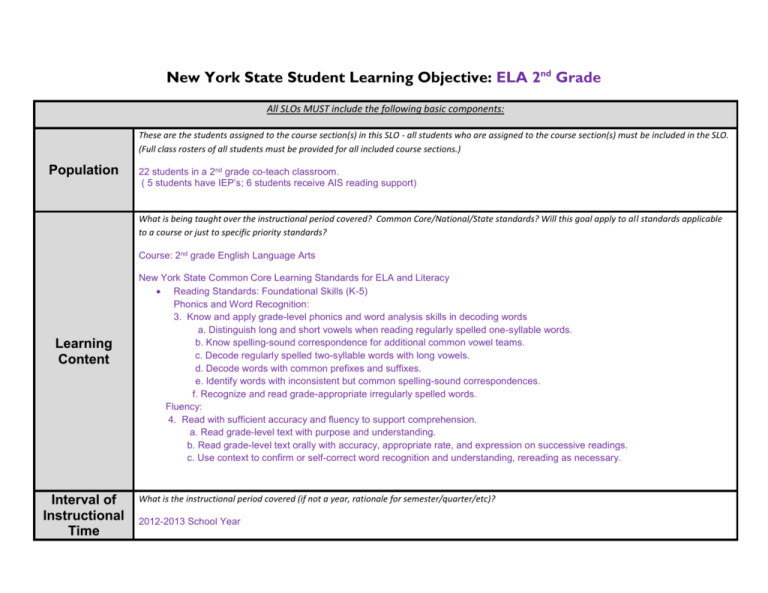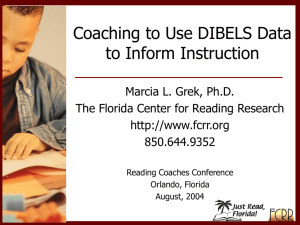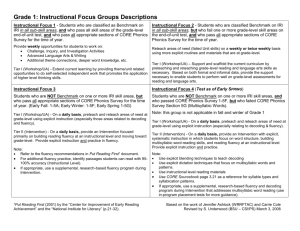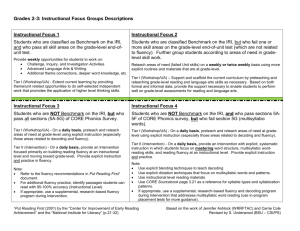New York State Student Learning Objective Template
advertisement

New York State Student Learning Objective: ELA 2nd Grade All SLOs MUST include the following basic components: These are the students assigned to the course section(s) in this SLO - all students who are assigned to the course section(s) must be included in the SLO. (Full class rosters of all students must be provided for all included course sections.) Population 22 students in a 2nd grade co-teach classroom. ( 5 students have IEP’s; 6 students receive AIS reading support) What is being taught over the instructional period covered? Common Core/National/State standards? Will this goal apply to all standards applicable to a course or just to specific priority standards? Course: 2nd grade English Language Arts Learning Content Interval of Instructional Time New York State Common Core Learning Standards for ELA and Literacy Reading Standards: Foundational Skills (K-5) Phonics and Word Recognition: 3. Know and apply grade-level phonics and word analysis skills in decoding words a. Distinguish long and short vowels when reading regularly spelled one-syllable words. b. Know spelling-sound correspondence for additional common vowel teams. c. Decode regularly spelled two-syllable words with long vowels. d. Decode words with common prefixes and suffixes. e. Identify words with inconsistent but common spelling-sound correspondences. f. Recognize and read grade-appropriate irregularly spelled words. Fluency: 4. Read with sufficient accuracy and fluency to support comprehension. a. Read grade-level text with purpose and understanding. b. Read grade-level text orally with accuracy, appropriate rate, and expression on successive readings. c. Use context to confirm or self-correct word recognition and understanding, rereading as necessary. What is the instructional period covered (if not a year, rationale for semester/quarter/etc)? 2012-2013 School Year What specific assessment(s) will be used to measure this goal? The assessment must align to the learning content of the course. Baseline: A district-generated running record assessment will be conducted during September, employing running records to assess instructional reading level (should be @ Level J for beginning 2 nd grade); a word assessment (students should know 220 ‘service words’ by the end of 1st grade); and a phonics inventory (students should have mastered CVC, CVCE, blends, & digraphs by the end of 1 st grade). Evidence Summative Assessment: A district-generated running record assessment will be conducted in June, employing running records to assess instructional reading level (will be scored for words per minute and accuracy %) and a phonics inventory (including long/ short vowels, vowel teams, 2 syllable words w/ long vowels, words w/ prefixes and suffixes). IEP testing accommodations will be used (extended time, alternate location) What is the starting level of students’ knowledge of the learning content at the beginning of the instructional period? 1. The students (5) with IEP’s are reading on an early 1st grade instructional level. They identify all letters and consonant sounds. They are inconsistent in reading blends and digraphs. They can identify short vowel sounds in isolation, but are inconsistent in applying that knowledge when reading. They are reading less than 5 words per minute on beginning 2nd grade selections (Level J). Baseline 2. The students (6) receiving AIS instruction are reading on a mid-1st grade level. They identify all letters and consonant sounds, read cvc, ccvc, and cvcc words. They are inconsistent when reading v-c-e words in isolation. They are reading between 9 and 15 words per minute on beginning 2nd grade selections (Level J). 3. The remaining students are reading an average of 20 words per minute with an accuracy rate of 87% (Level J). They can identify vowel teams in isolation but are inconsistent in applying this to unfamiliar words in context. 4. Knowledge of sight words is highly variable. What is the expected outcome (target) of students’ level of knowledge of the learning content at the end of the instructional period? All students will have individual goals based on the pre-assessment; the target for the teacher is based on the aggregation of the individual growth. Target(s) Students will increase sight words by at least 1 word per week. (30 words) Fluency will increase at least 20 words per minute at an accuracy rate of 90% Instructional Reading Level will increase by 3 levels 85% of students will reach their individual goals. How will evaluators determine what range of student performance “meets” the goal (effective) versus “well-below” (ineffective), “below” (developing), and “well-above” (highly effective)? Highly effective = 89% of students or more will meet or exceed their target goal on the summative assessment Effective = 80-88% of students or more will meet or exceed their target goal on the summative assessment Developing = 68-79% of students or more will meet or exceed their target goal on the summative assessment Ineffective = 67% or fewer students will meet or exceed their target goal on the summative assessment HEDI Scoring HIGHLY EFFECTIVE EFFECTIVE DEVELOPING INEFFECTIVE 20 19 18 17 16 15 14 13 12 11 10 9 8 7 6 5 4 3 2 1 0 97100 % 9396% 8992% 88% 87% 86% 85% 84% 83% 82% 81% 80% 7879% 7677% 7475% 7273% 7071% 6869% 5767% 4656% 045% Describe the reasoning behind the choices regarding learning content, evidence, and target and how they will be used together to prepare students for future growth and development in subsequent grades/courses, as well as college and career readiness. Research supports the need for students to be fluent readers to comprehend what they are reading. This is necessary across all content areas When they are unable to read selections fluently, they spend too much effort in decoding word by word and loose the meaning of what they are reading. Reading fluency is impacted by automaticity with sight words and phonetic decoding. Rationale Adequate phonemic awareness skill should have been mastered in kindergarten and 1st grade. Students who did poorly on the phonics assessment (pre-assessment) will need remedial work/ reteaching in this area. Using a running record assessment we will be able to see if the students are applying the skills learned in an unrehearsed selection. We will also be able to target areas of specific concern. (e.g. Student does not read digraphs or student does not attend to punctuation when reading).










